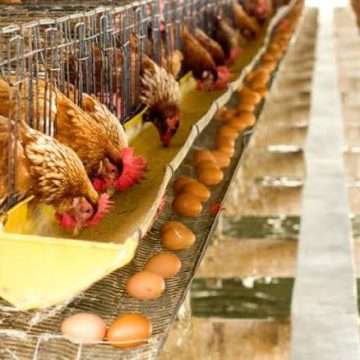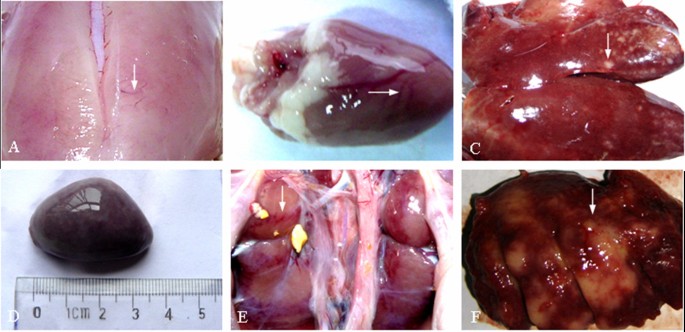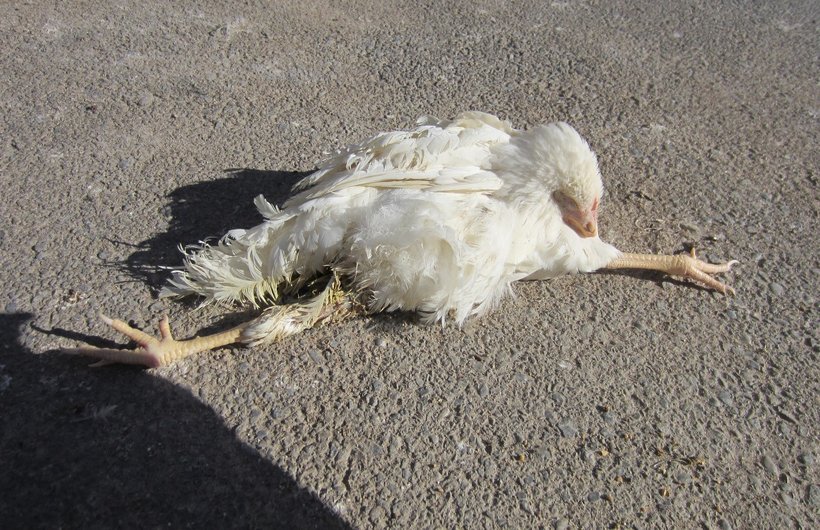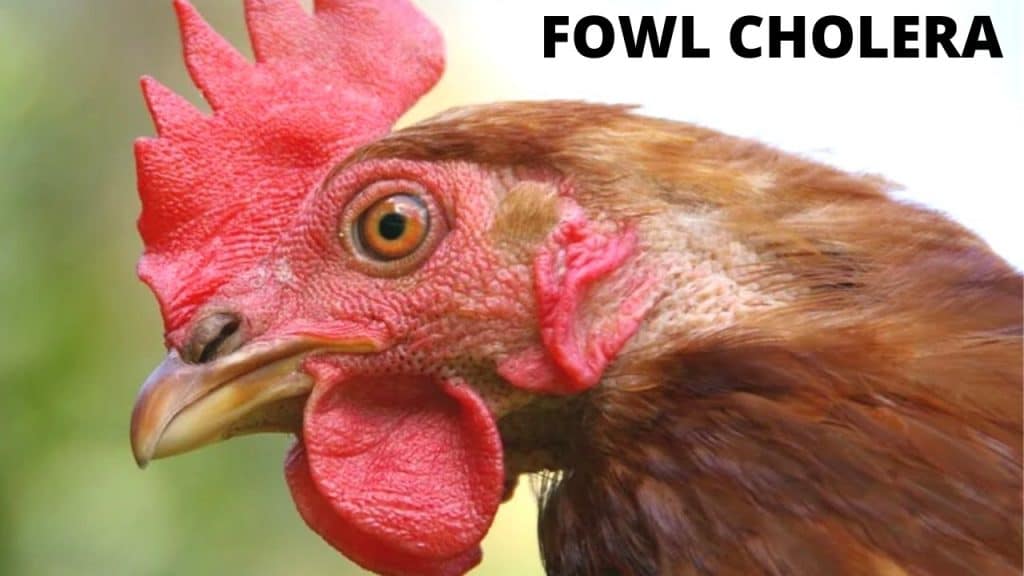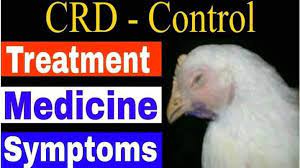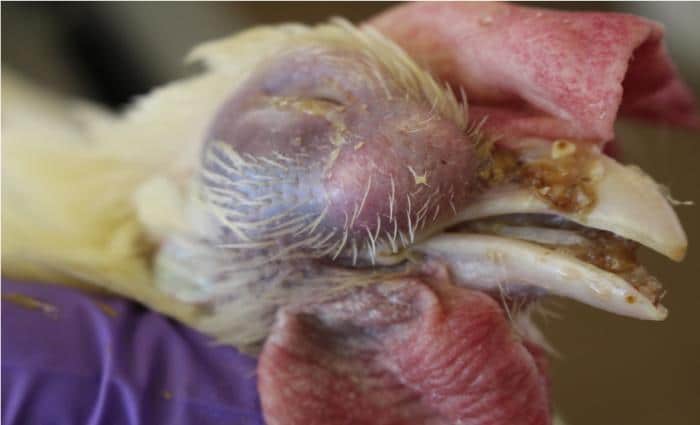Poultry farmers often experience sudden death in chickens, and this is caused by diseases most times.
Viral diseases are more deadly, but bacterial infections can also cause death to birds in poultry.
Today, I’d talk about some of the major chicken diseases, their symptoms, prevention, and treatment.
While there are drugs for most poultry diseases, the most effective way of preventing poultry diseases is to improve your management practices.
Poultry Diseases Symptoms and Treatment
There are hundreds of chicken diseases and clinical symptoms, and ways to manage them.
Lymphoid leukosis
Lymphoid leukosis is a neoplastic poultry disease and it’s caused by the avian leukosis virus, hence, it’s also referred to as avian leukosis.
The avian leukosis virus transmission is mainly through eggs, but transmission at a young age may also occur in birds.
Lymphoid leukosis affects birds that are older than 25 weeks, and unfortunately, there is no treatment for this viral infection.
It’s important to note that lymphoid leukosis can not be transmitted to humans, but it’s contagious amongst birds.
Lymphoid leukosis chicken symptoms
It causes cancer of internal organs such as the spleen, kidneys, liver, heart, and bursa of Fabricius.
Other Lymphoid leukosis chicken symptoms are the following
- Slow growth rate
- Lightweight
- Listless, pale
- A Drop in egg production in layers
- The weakness of birds and eventually death.
Prevention
The most effective way to prevent Lymphoid leukosis disease in your poultry is to purchase birds from hatcheries without a history of the disease.
The treatment of lymphoid leukosis in poultry may be almost impossible, therefore, good hygiene is important.
Mareks Disease
Mareks disease or paralysis is a common deadly poultry disease and it’s caused by the herpes virus.
The disease causes changes to the nerves and leads to paralysis and death after a few days.
Marek’s Disease symptoms
Marek’s disease chicken’s symptoms are the following.
- Loss of appetite
- Reduced weight
- Depression
- Restlessness
- Pale or/and shrunken combs
Paralysis is another clinical sign, and when this occurs, the chance of recovery is very low.
Paralysis makes the bird lying on its sides with one leg stretched forward and the other backward.
How to Prevent Marek’s disease in chickens
The best way to prevent Marek’s disease in chickens is to purchase birds from hatcheries without a history of the disease.
Good hygiene is also important, and once you notice, and confirm Marek’s disease, such bird should be destroyed and buried outside the farm.
Day-old chicks are infected through the oral and respiratory routes.
The disease starts manifesting at the point of lay, and you should vaccinate your birds at a day old.
Marek’s disease has no reliable treatment or vaccine but you can vaccinate your birds early to prevent the disease.
Egg Drop Syndrome (EDS) in layers
Egg drop syndrome is the production of soft shelled eggs or eggs without a shell, and also a reduction in egg production.
The egg drop syndrome can be fatal in layers. The causative virus is transmitted through the egg to a few birds in the flock.
These birds carry the virus until the flock comes into the lay at which time they begin to exercise the virus and infect the birds kept in the same house.
Symptoms of egg drop syndrome in chickens
- The inability of layers to peak at a lay
- Loss of appetite
- Soft-shelled eggs
How to prevent Egg drop syndrome
You can only prevent egg drop syndrome by vaccination.
Egg drop syndrome vaccine
There is no egg drop syndrome treatment, but antibiotics and vitamins can be given to protect them from other infections.
Fowl Cholera
Fowl cholera is a bacterial and infectious disease caused by Pasteurella multocida.
Chickens of all ages can be affected by this avian disease.
Poultry birds may suddenly be found dead, even though they were previously looking healthy.
Fowl cholera signs and symptoms
- Loss of appetite
- A drop in egg production
- Weak and convulsion
- Ocular, nasal, or oral discharge
- Ruffled feathers
- Greenish diarrhea
- Wattles and combs may appear bluish
Fowl cholera Prevention
- Vaccination
- Strict hygiene
- Isolation of all infected birds
Management of Fowl cholera
Fowl cholera can be well controlled, especially with antibiotics such as penicillin, tetracycline, sulfadimethoxine, and erythromycin.
Chronic Respiratory Disease (C.R.D)
The causative agents of CRD are bacteria. Other predisposing factors may also contribute such as stress from debeaking, vaccination, and other harsh conditions such as extreme cold or poor ventilation.
Infected breeders can transmit the organism via the eggs to their offspring. Infection can also be through contact or airborne dust or droplets.
CRD signs and symptoms
- Swollen face
- Nasal discharge
- Poor growth
- A drop in egg production
The clinical signs and mortality are more severe in broilers than in layers.
Chicken Pullorum Disease
This disease is transmitted from a breeder through their eggs.
Infected chicks can also affect other chicks via droppings. The disease affects birds from 1 – 3 weeks’ old
Chicken Pullorum disease signs and symptoms
- Chicks are seen huddled together as if they are feeling cold
- Loss of appetite
- Listless, ruffled, and droopy
- Standing for a long time in one position
- Whitish watery feces
- Sudden death
How to Prevent chicken Pullorum disease
Strict hygiene
Isolate all infected birds
Avoid stress
Management of this disease
You can control chicken pullorum disease with antibiotics.
Fowl Typhoid
This is a disease in adult chickens and it is characterized by high morbidity and mortality. The disease can spread in a flock through infected droppings, dead birds carcasses, contaminated clothing, equipment, etc
Clinical signs of Fowl typhoid
- Reduced feed intake
- Listlessness
- Evidence of intense thirst
- Pale and shrunken combs and wattles
- Yellowish diarrhea
How to Fowl typhoid
- Strict hygiene
- Isolate all infected birds
- Avoid stress
Treatment of Fowl typhoid
This disease can be treated with antibiotics
Infectious Coryza
This disease can spread within a flock through direct contact, airborne infected dust particles, and via drinking water, personnel, and equipment.
Signs and symptoms of Infectious Coryza
- Sneezing and coughing
- Respiratory distress
- Swollen face and wattles
- Foul-smelling discharge from nostrils and eyes
- Drop-in feed and water intake
- A drop-in feed and water intake
- A drop in egg production
How to prevent Infectious Coryza
Vaccination
Antibiotics
Management of Infectious Coryza
Remove all infected birds promptly
Give sulfur drugs
Coccidiosis
This is a disease of economic importance in chicken production. Transmission between birds in a flock is mostly through infected droppings containing the oocysts of the coccidian.
It is mainly a disease in young chicks, but the outbreak has been reported in adult birds.
Affected birds may have white mucoid or bloody diarrhea, ruffled feathers, loss of weight, etc.
Symptoms of Coccidiosis
- Hunched back
- A dropping of wings
- Birds appear sleepy
- loss of appetite
- A drop in egg production
- Bloodstained droppings
Prevention of Coccidiosis
- Good litter management
- Strict hygiene
- Vaccination
- use coccidiostat in feed or water
Management of Coccidiosis
Sulpha drugs
Amprolium
Helminthiasis
There are four different types of helminths (worms) that are of economic importance in chickens. They are
- Tapeworms
- Roundworm
- Threadworms
- Caecal worms
Clinical signs of Helminthiasis
Tapeworm seldom causes serious damage except that they deprive the host chicken of nutrients, but the larvae form of the roundworm and capillaries can cause the destruction of the intestinal lining which may lead to enteritis, anemia, drop in egg production, and in some cases pale yolked eggs, generally referred to as platinum yolks.
Prevention of Helminthiasis
Good litter management
Routine deworming
Management of Helminthiasis
Use appropriate dewormer.
Lice Infestation
Lousiness is a common consequence of poor management and overcrowding.
Clinical signs of Lice Infestation
- Discomfort
- Loss of blood from frequent sucking of the lice
Prevention of Lice Infestation
- Delouse
- Avoid crevices on the walls
Management
Delouse
Mites infestation
Two types of mites are of economic importance in chicken. They are-
Depluming mites
Red mites
Clinical signs of Mites infestation
They are found at the base of the feathers leading to feather loss and restlessness
- Irritations
- Reduced feed consumption
- A drop in egg production
- Prevention
- Good hygiene
Management
Use Acaricides
Malabsorption Syndrome
This is a disease common with broilers and is caused by viral and bacterial agents.
The causative agents primarily attack the digestive which may manifest as nutritional deficiency lesions.
This disease has variously been referred to as helicopter disease, femoral head Necrosis, Brittle bone disease, infectious Proventriculitis, Pale bird syndrome, Runting disease, and stunting disease.
Clinical signs of Malabsorption Syndrome
- Early diarrhea in chicks from 2 weeks of life
- Light or dark brown foamy droppings with traces of undigested food particles
- Mal-positioned wing feathers
- Rickets and femoral head necrosis
- Growth retardation
Management of Malabsorption Syndrome
All affected birds should be culled
Dietary supplementation of feed with vitamin E and Selenium could offer some palliative assistance
Strict hygiene
Rickets
Young chicks of 2-5 weeks are commonly affected
Clinical signs of Rickets
The weakness of the legs, claws, and beak
Soft-shelled eggs in layers
Prevention of Rickets
Provide well-balanced feed with adequate minerals (calcium, Phosphorus) and Vitamin D
Vitamin Deficiency
In young chicks, Vitamin B2 deficiency may be seen leading to their inability to walk.
Clinical signs of Vitamin Deficiency
- Drowsy, in-coordination
- Poor feathering
- Fall in egg production
- Reduced hatchability
- Convulsion
- Backward retraction of the head
- Death
Prevention of Vitamin Deficiency
Multivitamin supplementation
Management of Vitamin Deficiency in chicken
If the disease has not caused irreversible damages, give appropriate supplementations.
Infectious Synovitis
This disease can be transmitted from the infected breeder to its offspring through eggs. Other means of contact are through the chicken to chicken contact, personnel, clothing, and equipment.
Clinical signs of Infectious Synovitis
- Weight loss
- Inability to walk
- Swollen hock joint and feet which are hot to touch
Prevention of Infectious Synovitis
Good litter management
Hatching eggs should be dipped before setting
Management of Infectious Synovitis
Give antibiotics
Thrush or Moniliasis or Sour crop disease
This is a mycotic disease of the digestive tract of chickens caused by candida Albicans.
Young chicks are more susceptible and malabsorption of feed occurs following administration of therapeutic levels of various antibiotics.
Clinical signs of Thrush
- Stunted growth
- Listlessness
- Ruffled feathers
- Foul-smelling discharge from the mouth
- Loss of appetite and weight
Prevention of the disease
Good hygiene
Avoid overcrowding
Management
Remove affected birds
Give copper sulfate in drinking water
Spirochaetosis (Tick fever)
It is caused by a bacterium Borrelia anserine and infection is by ingestion of contaminated feces, feeds, fowl ticks, etc.
Birds of all ages are susceptible but older birds are more resistant and may receive spontaneously.
Clinical signs of Spirochaetosis
- Increased body temperature
- Darkened head part
- Increase in thirst
- yellowish-green diarrhea
- Combs and wattles are pale
- High mortality
Prevention of Spirochaetosis
- Avoid thick infestations
- Management
- Destroy ticks with acaricides
- Apply arsenicals and antibiotics
Aspergillosis
This is a fungal disease of chickens. Transmission is primarily through inhalation of fungal spores from contaminated litter like wood shavings it contaminated feed.
Clinical signs of Aspergillosis
Depressed breathing, gasping, and coughing
Prevention of Aspergillosis
Strict hygiene in breeder and hatchery
High-quality fungal spore-free wood shavings should be used
Management of Aspergillosis
Affected birds should be culled and destroyed
Miscellaneous Abnormalities
Prolapsed of the oviduct
This is the version of the oviduct and rectum through the vent to the extent that it cannot go in again.
Affected birds should be slaughtered. Faulty feeding leading to over-fatness, unregulated lightening programs and early introduction of pullets to layers diet can lead to this abnormality.
Hormonal imbalances, extra-large eggs, physical injuries to the oviduct such as pecking of the vent, and severe worm infestation can also cause the prolapse of the oviduct.





